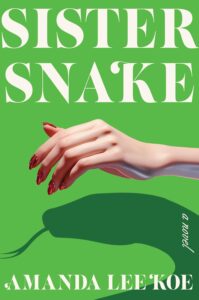Su and Emerald are sisters with nothing in common: Su lives in Singapore, playing the perfect wife to her conservative politician husband. Emerald is a queer sugar baby in New York, barely scraping by living with an artist friend. While their current lives look very different and they rarely speak, they have a shared past: they were both snakes hundreds of years ago in China.
Emerald embraces the dual sides of herself, snake and human. She slips between forms when convenient and has even let a few people in on her secret—though that hasn’t always ended well for her. Su, on the other hand, is ashamed of it. She practices walking without a slink, hides any hissing sibilance in her speech. She won’t transform even to molt, repressing the overwhelming itch.
When they were snakes, the two of them couldn’t have been closer. As humans, they can’t seem to get along. Over the centuries, they keep coming together and then hurting each other, splitting apart until the next iteration of this cycle. It’s like a toxic relationship, but familial.
Queer books often celebrate found family, understandably. Sister Snake explores how found family can hurt you just as much as biological family. Su and Emerald aren’t biologically related—they weren’t even the same species of snake. But they helped each other survive, caring for each other selflessly. Together, they found the secret of immortality and transformation between forms. Their relationship, built over centuries and across continents, is impossible for anyone else to equal. And yet, they can’t seem to understand each other. Every time they reach out to each other, they’re hurt. The truth is, like biological family, found family can know you so intimately that they can also wound you like no one else.
Described one way, this sounds like a fantasy novel: Su and Emerald have vampire-like qualities, living for centuries and feeding off humans’ chi. This story, based on the Chinese “Legend of the White Snake,” feels much more litfic than fantasy, though. It’s about racism, misogyny, assimilation, and conformity. Emerald, as the pleasure-seeking queer heroine of this story, is a fun character, but overall, the tone is melancholic. I loved this story, but don’t go in expecting a typical fantasy novel.
While most of the book takes place in Su and Emerald’s present life, I enjoyed the glimpses into their pasts, from their time together as snakes in Tang dynasty China to attending Hirschfield’s lectures on the rights of homosexuals in pre-WWII Germany to their disastrous attempt to live together in Victorian England.
As for the Lesbrary-relevant content, her queerness is an important part of Emerald’s identity. Her best friend that she lives with in New York City is also queer, and I loved the relationship that developed between them—it’s a sweet moment of queer friendship and solidarity. Emerald also has some women love interests during the book, and there’s a F/F relationship between side characters, but there isn’t a prominent romance plot.
This is such a thoughtful, layered book, and I feel like I’m only beginning to pull apart what it has to say about family, assimilation, and passing. It’s one I would love to discuss with other readers, so this is your invitation to pick it up and tell me your thoughts!
Content warnings: Rape, assault, transmisogyny (this is a significant plot, not just mentioned in passing), pregnancy trauma, misogyny, homophobia.



